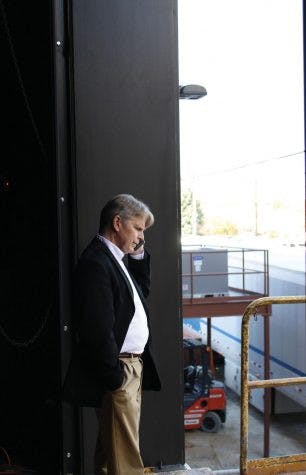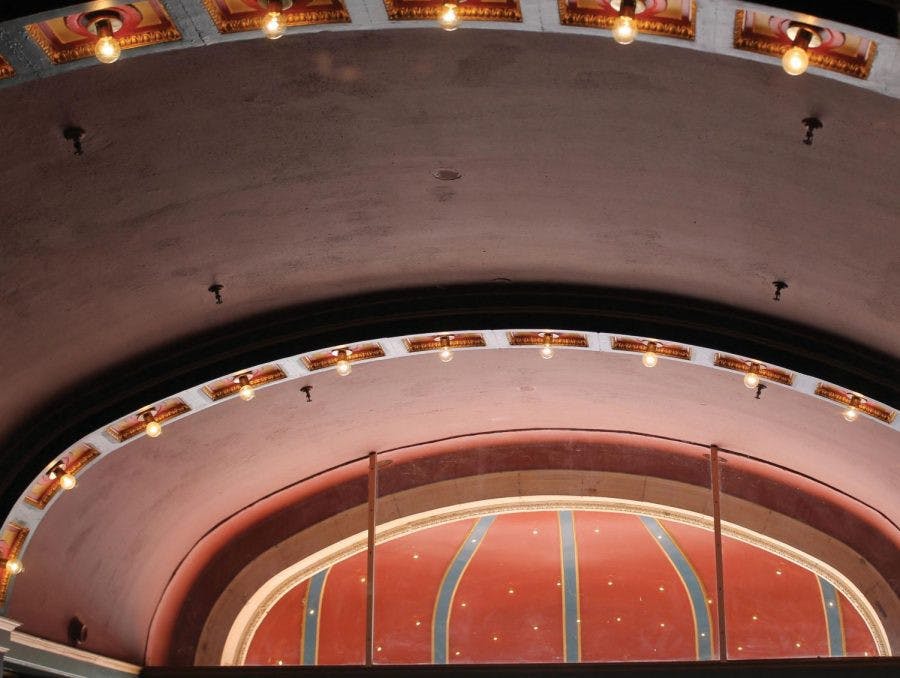After months of anticipation the Grand Opera House has finally reopened presenting its new renovations.
The new carpet feels comfortable as the foam bends and molds to each step of the foot. It is red and unworn. There are no signs of treadmarks anywhere.

Caption: Executive Director Gram Slaton takes a work phone call at the Grand's new stage loading dock door, which was expanded by 50 percent. The stage lift will be replaced in January.
Gram Slaton, executive director of the Grand, says theatre carpet is supposed to last 30 to 40 years
The previous flooring in the lobby was 30-year-old hotel carpet, which only has a lifetime of three to five years.
“That’s called dorm room carpet,” said Slaton, explaining that the previous flooring was dingy with years of drink stains saturated in it.
Renovations at the Grand began Aug. 1 with a plan to install new carpeting, install historically correct seating, make subsequent changes to heating and air and expand the stage loading dock door by 50 percent.
The work was complete on Oct. 12, when the symphony moved back in.
The funds for the renovations came through a Macon voter selected Special Purpose Local Option Sales Tax (SPLOST), which allocates money to county projects aimed to improve quality of life and safety.
The SPLOST includes funding city infrastructure projects. The Grand had to lobby for a portions of those funds to be allocated for their restorations.
Slaton said that old theatres like the Grand are costly to keep up, especially in the South where weather and humidity play a role in causing deterioration.
The Grand Opera House opened its doors in 1904.
It is the longest running theatre in Macon and at one time held the largest stage in the South.
It was built large enough to hold a production of Ben Hur with a live horse and chariot race, which was performed in 1908.
As Slaton walks around the seating area of the theatre, the chairs are wooden now with a bigger seat pan. They are stained in a light natural wood color and upholstered in blue.

The Grand's theatre seats were replaced by historically accurate chairs that emulate the 1890s to the 1930s as part of new renovations.
The floors have been brought back to be wooden with aisle lined in carpet as it would have looked in the 1920s.
The chairs are historically accurate and emulate a common style of theatre seating available from 1890 to the 1930s.
“[The seating] was in dire need of replacement,” said Slaton.
The previous chairs were dark green, metal high school auditorium seats, that were purchased from a local school in the 1970’s.
As Slaton stands at the stage loading dock door to take a work related phone call, the door is much larger today.
The door now spans the width and height of a commercial truck trailer.

As Broadway shows have gotten bigger, so have their set designs.
The previous stage door was too small to load in all of the scenic elements from touring shows that perform at the Grand.
This was a problem with last season’s production of “Annie” when the iconic oversized Christmas tree and front steps of the final scene could not be loaded into the building.
According to Slaton, this was a let down to audience members who knew the show.
“You [now] will be getting the show that you pay for,” said Slaton.
There is still much to be done at the Grand.
Slaton said that the two biggest complaints for the opera house have been the seats and the insufficient size of the restrooms.
Next year the restrooms will be remodeled and the front lobby will be expanded and rewired to feature chandeliers that once graced the space.
“We had to carefully select which projects we wanted to do,” Slanton said. “ And now, we have all winter to think about [it].”
The Grand Opera House opens after major renovations

Executive Director Gram Slaton holds one of the H's from the new theatre seats above the recently laid red lobby carpeting.
Elliot James
Elliot James



